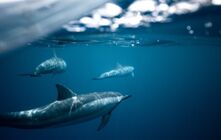|
保护生物多样性及生态系统的成本惊人,但是专家们清楚,如果听任破坏继续,花费就会更多。 Somewhere between $103 billion and $895 billion a year – that is how much funding will be needed to “bend the curve” on global nature loss, according to several recent estimates.
最近的几份估算研究显示,要想扭转全球生态损失的曲线,每年的花费将达到1030亿至8950亿美元。 Campaigners and academics have been striving to convince governments and the private sector that the current loss of nature – dubbed by scientists the “sixth mass extinction” – poses a threat not just to species and ecosystems, but also to economies.
科学家们将目前的生态破坏称为“第六次大灭绝”。环保人士和专业学者一直试图让政府和私营部门相信,这种“灭绝”不仅会威胁自然物种和生态系统,还会同时威胁经济发展。 
Now, an expert panel convened by the UN Convention on Biological Diversity (CBD) has analyzed various estimates of the costs and benefits of conserving nature. The analysis is part of work surrounding international negotiations on a new deal for nature, which will be agreed in Kunming, China, in May 2021.
联合国《生物多样性公约》(简称CBD)召集的一个专家小组已经对保护自然的成本和收益进行了估算分析。2021年5月在昆明召开的大会上将达成一项全球性的自然保护新协议,而上述分析正是围绕这一协议的若干国际谈判相关工作的一部分。
New targets under discussion would see areas protected for nature on both land and sea increased from 17% to at least 30%. The new goals will replace the Aichi targets agreed in 2010, which the CBD recently confirmed had mostly failed.
正在讨论的新目标拟将陆地和海洋保护面积从17%提升到至少30%。这些目标将取代2010年达成的“爱知目标”。《生物多样性公约》前不久确定“爱知目标”大部分未能实现。
The lower funding range, of $103-178 billion, is based only on investments in expanding protected areas, the panel noted.
专家小组指出,1030亿至1780亿美元的较低资金估值是只考虑扩大保护区面积的情况下,按照目前每公顷保护区的预算支出计算得出的所需投资。
The larger range, of $631 billion to $895 billion, takes into account the cost of making the agricultural, fishery and forestry sectors sustainable, conserving biodiversity in urban and coastal areas, managing invasive species, and protecting urban water quality – all of which currently drive biodiversity loss.
而6310亿至8950亿美元的较高资金估值则考虑了农、林、渔等产业活动的可持续发展,城市和沿海生物多样性保护,入侵物种管理,城市水质保护等减缓现有生态多样性损失措施的成本。
Despite differing methodologies, the CBD expert panel noted that these estimates all reach the same conclusion: investment must increase substantially from current levels.
《生物多样性公约》专家小组指出,虽然估算方式不同,但重点在于它们都得出了相同的结论,那就是必须在现有基础上大幅提升生态保护资金支持力度。
The panel also stressed that continuing on current trajectories of nature destruction will lead to significant global economic costs. It pointed to an analysis by campaign group WWF that estimates the loss of “services” provided by nature, such as crop pollination and clean water supply, at nearly $500 billion a year. Investing to protect nature would save money in the longer term by reducing the amount needed to tackle problems caused by losing these services, it said.
专家小组还强调,如果任由全球生态继续沿着当前的轨迹破坏下去,将给全球经济带来巨大的损失。世界自然基金会(WWF)项目组分析显示,农作物授粉和清洁水供应等生态系统“服务”减少导致的损失将达到每年近5000亿美元。投资生态保护能够减少应对上述服务缺失而产生的成本,从长远来看反而可以节约资金。
Aichi funding fail
“爱知目标”资金支持不足
Finance is a key issue for the new nature deal. Even though financial resources and official development assistance for biodiversity had roughly doubled to reach around $80-90 billion per year by 2020, the Aichi targets still failed.
资金对达成这项新的公约至关重要。到2020年生物多样性改善相关的财政投入和官方发展援助已经翻了一番,基本上达到了每年约800亿至900亿美元。尽管如此,还是没能实现“爱知目标”。
Not only was this funding nowhere near the scale needed, but it was also swamped by subsidies for activities that harmed biodiversity, such as the production of commodities linked to forest destruction, estimated at around $500 billion a year, according to the CBD’s Global Biodiversity Outlook 5 report.
根据《生物多样性公约》发布的《第五版全球生物多样性展望报告》,用于自然环境保护的资金不仅远远没有达到所需规模,甚至还不如生物多样性破坏活动获得的补贴多,例如与森林破坏有关的商品生产每年获得的补贴就达到近5000亿美元。
However, so far, finance has not been discussed at all by negotiators, according to Li Shuo, senior global policy adviser for Greenpeace East Asia. Discussions leading up to the agreement of the Aichi goals set a precedent for this – though the goals were set in 2010, the level of public international finance was not agreed until 2012. A further meeting in 2014 saw this level doubled, but that was too late considering the deadline of 2020, he said.
绿色和平东亚分部全球政策顾问李硕(音译)称,到目前为止,谈判各方尚未就生态保护资金问题进行讨论。达成“爱知目标”的讨论就是前车之鉴——尽管“爱知目标”是在2010年达成的,但直到2012年各方还未就国际公共财政支持规模达成一致。在2014年的进一步会谈中,虽然达成的公共资金规模翻了一番,但对2020年的截止日期来说已经太晚了。
“Regardless of how many reports on finance are produced, they will not be useful if we don’t actually talk about it in official negotiations,” Li said. “If they don’t agree the whole finance package in one go in Kunming, then the credibility of the deal will be significantly challenged,” he added.
李硕说:“无论发布多少财务报告,如果我们没有在正式谈判中讨论这个问题,那么这些报告就都是没用的。”他补充说:“如果他们不能在昆明会议上就资金支持一次性达成一致,那么协议的公信力就将受到极大挑战。”
Filling the gap
如何填补资金空白
The CBD’s finance panel recommends a three-pronged strategy to fill the funding gap:
《生物多样性公约》财务问题小组建议采取三管齐下的策略来填补资金缺口,分别是
Subsidies that harm biodiversity need to be reduced or redirected.
减少或调整对生态有害的补贴; Existing investments must be scaled up while more is generated from all sources.
增加现有投入,同时需要从包括国内和国际,私人和公共在内的所有渠道筹集更多资金; The efficiency of resource use must be improved, through sound governance and planning, and effective monitoring and review of results.
通过健全的治理和规划,以及有效的监督和结果审查来提高资源利用率。
Andrew Deutz, director of global policy, institutions and conservation finance at environmental organisation The Nature Conservancy (TNC), believes that up to half the funding gap for nature could be closed without new money.
大自然保护协会(TNC)全球政策、机制和生态金融总监安德鲁·道依茨认为,多达一半的资金缺口可以在不增加新的资金投入的情况下得到弥补。
“Much of what we need is better deployment of existing funds and smarter policy and investment choices,” he said.
他说:“我们最需要的是更好地调配现有资金,以及更明智的政策和投资选择。”
TNC, together with US-based think-tank the Paulson Institute, and academics from the Cornell Atkinson Center for Sustainability, this month published a blueprint for decision-makers on closing the funding gap, which it estimates at between $598 billion and $824 billion a year.
大自然保护协会、保尔森研究所以及康奈尔大学阿特金森可持续发展中心的多位学者本月发布了一份缩小自然资金缺口的决策者蓝图文件。该文件预计的资金缺口大约在5980亿美元至8240亿美元之间。
This will rely heavily on government action, with reform of harmful subsidies the single biggest opportunity, it said.
文件指出,缩小资金缺口需要政府的鼎力支持,而最可行的措施就是对有害补贴进行改革。
Governments must also develop new financial innovations for conservation, promote green investments, and support nature-based climate solutions, natural infrastructure and biodiversity offsets, it states. The right regulatory environment and incentives need to be in place to catalyse financial flows from the private sector, it said.
文件认为,各国政府还必须为保护自然环境开发新的金融创新措施,促进绿色投资,支持基于自然的气候解决方案、自然基础设施和生物多样性补偿,并且需要通过正确的监管环境和激励措施来促进私营部门的资金流动。
Speaking at a webinar to launch the report, Jennifer Morris, TNC chief executive said that none of the solutions presented were novel. What was new was “the very clear conclusion that we need an all-of-the-above approach”.
大自然保护协会首席执行官詹妮弗·莫里斯在发布这份报告的网络研讨会上表示,这些解决方案都不新奇,新的是“非常明确地得出了上述所有方法一个都不能少的这样一个结论”。
The conservation sector had recently been focusing on leveraging private funds for nature, but Morris said that though this was important, on its own the private sector could not deliver more than 3% of what was needed.
近来,环保部门一直致力于利用私有资金促进自然保护。但是莫里斯认为,尽管这很重要,但就其本身而言,私营部门提供的资金最多也不到所需资金的3%。
Ahead of COP15, governments should estimate the finance gap for protecting and restoring nature in their own country, and develop a road-map to fill it, she said.
她说,在昆明大会召开之前,各国政府应对保护和恢复本国自然资源面临的资金缺口进行估算,并制定出填补这一缺口的路线图。
“The biggest opportunities lie in the intersection of public and private sector investment. We need the right policies, regulations and incentives so that the vast majority of private sector spending helps not hurts nature. We will then put nature on our collective balance sheet as a critical asset we must protect,” she said.
她说:“最有可能填补这一缺口的解决方案是结合公共和私营领域的资金投入。我们需要颁布正确的政策、法规和激励措施,确保绝大多数私营领域支出不损害自然。然后,我们将把自然资产作为必须保护的关键资产列入全人类的资产负债表中。”
| 








